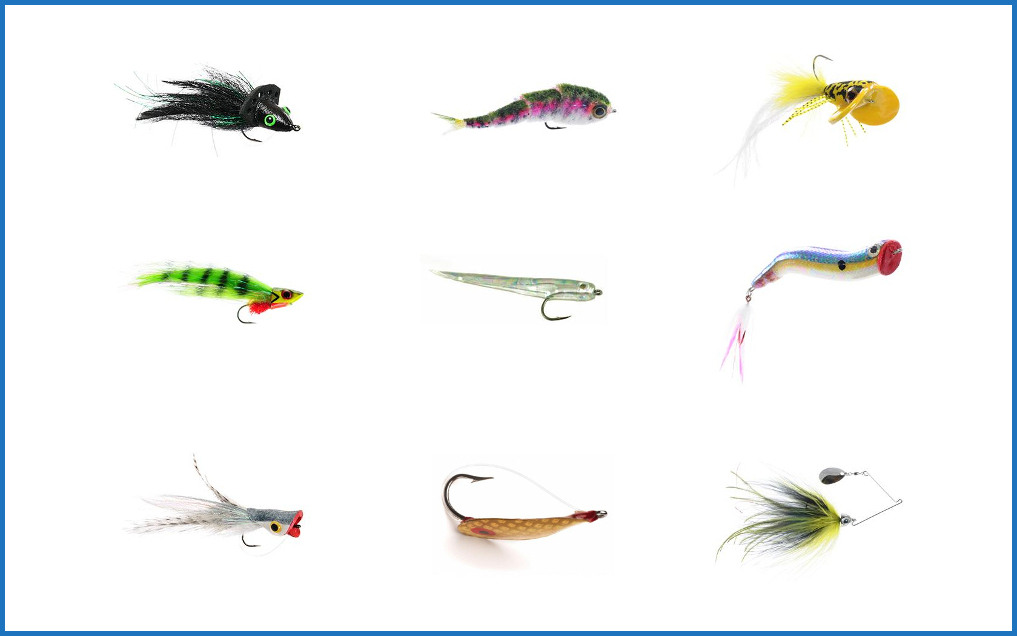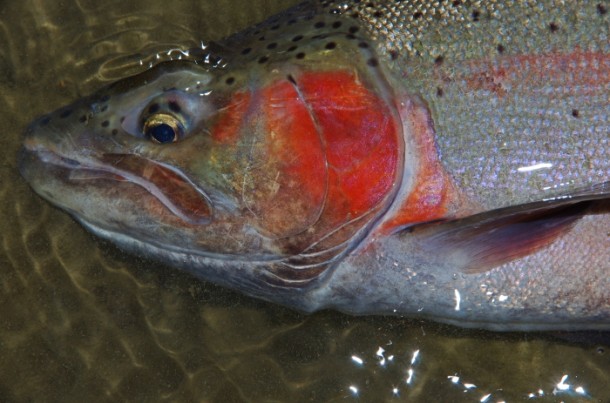The majority of fly anglers do not study the origins of fly fishing or have any idea when “fly fishing” began. I, myself, didn’t really become at all interested in the earliest forms of fly fishing until I was crossing the backed-up waters of the Haliacmon river in Northern Greece, while on a trip to see ancient tombs possibly meant for Alexander the Great’s father. As I crossed this river, I scanned the water under the bridge to see if I could catch sight of anything swimming. Toward the end of the bridge, I saw schools of trout slowly moving along the bank. I wanted to stop the bus and cast to these fish but had no rod to speak of. I realized I didn’t know much about fly fishing in Greece or even about when “fly fishing” began.
A few miles from this body of water, Aelian (on animals 15.1-2), the ancient Roman rhetorician, referenced a river, perhaps the Arapitsas, in which the locals used a short six foot rod and a six foot line, similar to a short Tenkara rod. The locals used this rod to present a hook made from the feathers of a chicken and wool to imitate a delicate fly (musca), called a hippurus, which colorful fish gulped. This, as far as we can tell, is either the first (or one of the first) references to “fly fishing”.
 The development of what is “fly fishing” today from what some locals in northern Greece were doing nearly 2,000 years ago is a complex history in itself. There are, however, some interesting aspects to Aelian’s description: 1) this form of fishing is a different tactic with respect to other forms of fishing of the day, 2) it’s done at close distances with respect to the fish, 3) the technique is used since the insect itself is much too fragile to place on a hook and is an insect, not a minnow etc., 4) there is a process of creating a lure/fly out of biological materials, 5) the fish are carefully sucking in these insects, 6) the fishing is in a river. Had Aelian said that these fisherman were wearing tweed, casting down and across, and were on an English chalk stream, we could think how very little had changed until the 20th century.
The development of what is “fly fishing” today from what some locals in northern Greece were doing nearly 2,000 years ago is a complex history in itself. There are, however, some interesting aspects to Aelian’s description: 1) this form of fishing is a different tactic with respect to other forms of fishing of the day, 2) it’s done at close distances with respect to the fish, 3) the technique is used since the insect itself is much too fragile to place on a hook and is an insect, not a minnow etc., 4) there is a process of creating a lure/fly out of biological materials, 5) the fish are carefully sucking in these insects, 6) the fishing is in a river. Had Aelian said that these fisherman were wearing tweed, casting down and across, and were on an English chalk stream, we could think how very little had changed until the 20th century.
From the very beginning, the narrative of fly fishing has been framed a bit as some new and different technique compared to “other fishing” approaches. This should come as no surprise to modern fly anglers since fly fishing today not only has a concomitant culture along with it, but also the limits or boundaries of “fly fishing” never seem to have a certain end or definition, since it is only those who are involved in the activity, who define it. Since fly fishing is ever changing, a proper definition is somewhat difficult to pin down. What seems clear from the original description by Aelian is that the fishing situation/conditions demanded a certain type of presentation to be successful. The locals figured out how to be successful with a different presentation and lure. Therefore, we might say that fly fishing began as a solution, not a self-defining choice. This approach to catching a fish was simply an alternative among many of the day and required no club entry fees or ostracizing when one switched back to the “other” type of fishing. Although, Aelian understood it as an innovative technique.
FLY FISHING AND GENERAL TACKLE TODAY
Fast forward to this day, and fly fishing has become something different in many people’s eyes. Folks, who fish with primarily general tackle, on the other hand, really have not seen the need to give themselves a name or identity such as “general tackle angler” or “terminal tackle angler”. The reason for this is because people who fish this way use whatever method available to catch fish on a rod and reel. The presentation or technique that is most effective is the one they use. Professional bass anglers do not snub their nose at a technique that catches fish or gives them a competitive edge; in fact, they try to master these skills as fast as possible, and then they give their own spin on it. These guys and gals seem to have the mindset of the first “fly anglers”.

THINGAMABOBBERS OR REAL BOBBERS? MOST ASPECTS OF FLY FISHING HAVE BEEN INFLUENCED BY GENERAL TACKLE.
The modern diversity of fly fishing species and fishing opportunities have opened the door to innovation in a similar way to this tacit general tackle mindset, although the “right” way to fly fish is still being worked out even to this day. What is clear is that the requirements of presentation have caused anglers like Frank Sawyer, Joe Brooks, Lefty Kreh, Dan Blanton, Dave Whitlock, Bob Clouser, and Bob Popovics to innovate and change the face of fly fishing forever. The willingness to change and adapt was at the core of the fly fishing done in Northern Greece. Presentation drives innovation. You can continue to wrap a midge pattern with different threads for decades, but at the end of the day, it’s still a midge pupa or larva. It is difficulties and challenges in presentation for fly anglers that push the sport along. Difficulties include or have included weedlessness (to coin a word), vertical presentation, depth of presentation, efficient and effortless long casts (beyond 100 feet), suspending flies, flies with particular actions like the walk-the-dog action, vibration, smell, jigging action and fall, movement with small flies, the dynamic of the orientation of a fly and the surface film etc. Success in general tackle changes the very face of fly fishing as “indicators” now “bobbers” attest.
 General tackle has overcome most of these obstacles quite well, and because of this, fly anglers have resorted to unorthodox tactics involving general tackle techniques and lures like casting a spinner on a fly rod, launching a Dolly Llama on a spinning rod, or dipping their flies in Smelly Jelly or Berkley Gulp. Fly anglers have looked to general tackle more and more, as John Sherman puts it, “to level the playing field” between general tackle fishing and fly fishing. Forums, like Stripers Online, events/organizations like the Bass-n-fly in the Sacramento Delta, or even shows such as the Swedish Fly vs. Jerk are bringing both forms of fishing into closer dialogue. But general tackle has influenced fly fishing advances for a long time, and the most innovative flies of today have come almost invariably from anglers, who have had a close connection to general tackle fishing. Charlie Bisharat, Bob Popovics, Larry Dahlberg, Bob Clouser, and many other saltwater guides, who quite often switch from fly to spinning gear with their clients, have developed the most truly innovative patterns in fly fishing within the last 35 years based off of the desire to overcome specific challenges within fly fishing in close view of general tackle fishing techniques (whether consciously or not). As an example the Bubbleicious diver/popper was developed by Charlie Bisharat, which is a diving and gurgling fly for largemouth and distributed, along with the other patterns above, by Umpqua Feather Merchants. There can be no doubt that Larry Dahlberg’s Dahlberg’s Diver played an important intermediate example of a fabulous diving fly pattern. Dahlberg himself developed the Diver for bass after observing the action of a Muskie lure, called a Suick, which would dive and then resurface. General tackle plays a role in fly development and presentation at a ton of different levels, as far as the fly rod will allow.
General tackle has overcome most of these obstacles quite well, and because of this, fly anglers have resorted to unorthodox tactics involving general tackle techniques and lures like casting a spinner on a fly rod, launching a Dolly Llama on a spinning rod, or dipping their flies in Smelly Jelly or Berkley Gulp. Fly anglers have looked to general tackle more and more, as John Sherman puts it, “to level the playing field” between general tackle fishing and fly fishing. Forums, like Stripers Online, events/organizations like the Bass-n-fly in the Sacramento Delta, or even shows such as the Swedish Fly vs. Jerk are bringing both forms of fishing into closer dialogue. But general tackle has influenced fly fishing advances for a long time, and the most innovative flies of today have come almost invariably from anglers, who have had a close connection to general tackle fishing. Charlie Bisharat, Bob Popovics, Larry Dahlberg, Bob Clouser, and many other saltwater guides, who quite often switch from fly to spinning gear with their clients, have developed the most truly innovative patterns in fly fishing within the last 35 years based off of the desire to overcome specific challenges within fly fishing in close view of general tackle fishing techniques (whether consciously or not). As an example the Bubbleicious diver/popper was developed by Charlie Bisharat, which is a diving and gurgling fly for largemouth and distributed, along with the other patterns above, by Umpqua Feather Merchants. There can be no doubt that Larry Dahlberg’s Dahlberg’s Diver played an important intermediate example of a fabulous diving fly pattern. Dahlberg himself developed the Diver for bass after observing the action of a Muskie lure, called a Suick, which would dive and then resurface. General tackle plays a role in fly development and presentation at a ton of different levels, as far as the fly rod will allow.
DIFFERENCES AND ADAPTATIONS

IN-FISHERMAN HAS ALWAYS BEEN AT THE FOREFRONT OF INNOVATION. IN THIS CASE, FLY FISHING AND GENERAL TACKLE ARE REALLY CLOSE.
One of the most obvious defining differences between the two types of fishing is the use of weight to project a lure/fly. Unlike with general tackle and its world record near 1,000 foot casts, a fly rod fundamentally uses the weight of the line to load the rod while general tackle uses the weight of the lure. The use of weight draws flies closer and closer to general tackle lures. To an extra heavy fly, add lips, blades, and propellers, and you have a fly that can just as easily be cast with a spinning rod (although I’m not necessarily dissuading their use in fly fishing). Indeed, general tackle, with its eclectic nature, has taken ideas from fly fishing. Hair jigs have seen a revival of sorts among general tackle fisherman, which are more or less bucktails/clouser style flies, this is to say nothing of bonefish jigs. Traditional fly tying materials are being used in the process of making jigs, and natural materials such as marabou, bunny, and bucktail are a common component of jigs in addition to Sculpin Helmets. Lines and fly rods have been developed to throw this weight better, but the fact remains that flies are always better when they give the appearance of bulk and weight without actually having it if the most ideal presentation effect can be achieved, such as a jigging action. The reason for this is simply the ability to cast further and with more accuracy.
Thus, the most effective fly adaptations from general tackle are those that incorporate light materials. When this is not possible, heavier rods and lines must compensate in order to cast with any semblance of success. Is it any wonder, we have seen an ever increasing selection of fly lines from the leading manufacturers? This is where the innovation really happens, and the more or less simple taking over of a technique such as trolling behind a motorboat or chuck-and-duck nymphing with a running line seems to fall a bit short, despite their effectiveness. This gets into the ever-elusive, definitive description of fly fishing and the denigrating of what Dan Blanton calls an angler’s “personal game”. This topic receives endless debate, but the instant that someone uses a technique that can be made with any fishing rod at all, the use of a fly rod seems all but an afterthought from a functional standpoint. That is why adaptations from general tackle rather than blatant copies may seem more fulfilling to many of us.
Many fly anglers like to do both general tackle fishing and fly fishing depending on the most enjoyable or effective method, but if you’re like me, you don’t really have a lot of interest in fishing with a spinning rod or baitcaster and you take pride in figuring out how to overcome challenges that are inherent to using a fly rod, even if you use a spinning rod out of desperation. However, general tackle fishing has had and continues to have a huge amount to offer fly fishing at all levels and in many cases is much more sophisticated and subtle. This is to what many fly anglers have really been paying attention, as trends like articulated flies attest, and the flies, techniques, and approaches are changing the sport again. After all, fly fishing has always been about seeing a fishing challenge and creating a fly and appropriate presentation to overcome this challenge. Aelian would certainly recognize that!



